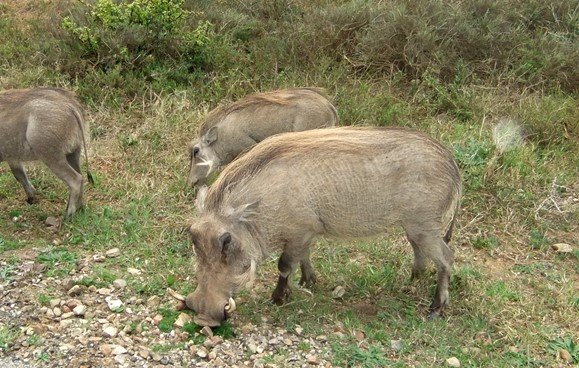Warthog

Warthog is at home in grassland. The Afrikaans name of vlakvark says pig of the plains (vlakte means open plain and vark is pig).
It eats grass, but as an enthusiastic omnivore the vlakvark ventures a lot further into gourmand or gourmet fashions. New sprouts on burnt grassland are particularly popular and it likes wild fruit.
Other farmers (like humans) may not resort to ploughing in the same seasons, using the same techniques or aim at the same outcomes, but warthog tusks, strong neck and shoulders serve to dig for roots and other subterranean delicacies successfully and on a regular basis.
Occasional dessert that may not be eschewed includes birds eggs, certain insects and worms. Snakes and mice are not to be sneezed at when, nose always near the earth, those are encountered. The warthog is known to partake of carrion and, being brave, it might rob a cheetah or some wild dogs of their prey. An attacker tends to remember warthog tusks after their first fight.
Without doctor’s orders the occasional piece of bone might be chewed by the warthog, either as intuitive self-medication or simply because the bone or the idea of it augmented the flow of saliva. Even soil may be ingested when such craving is caused by mineral deficiency or whim.
In spite of its wide range of dietary options and proclivities, the warthog is one of the first animals to lose condition when food quality deteriorates and its favourite mudhole(s) disappears during drought.
The longish tails hanging down when the business is eating or they are not alarmed (and also probably eating, for there isn’t much else to do in the veld for a warthog apart from sleeping). The moment risk is identified, it will run, the tail instantaneously erect, possibly as an antenna for the rest of the family to spot in the grass as a route indicator.
Although a speed of 45 km per hour may be achieved, this is usually not enough for escaping their common predators. So, they generally remain aware of the whereabouts of the nearest holes for a fast disappearance during emergencies, hoping the pursuer can’t follow (Riëtte, 2016).

